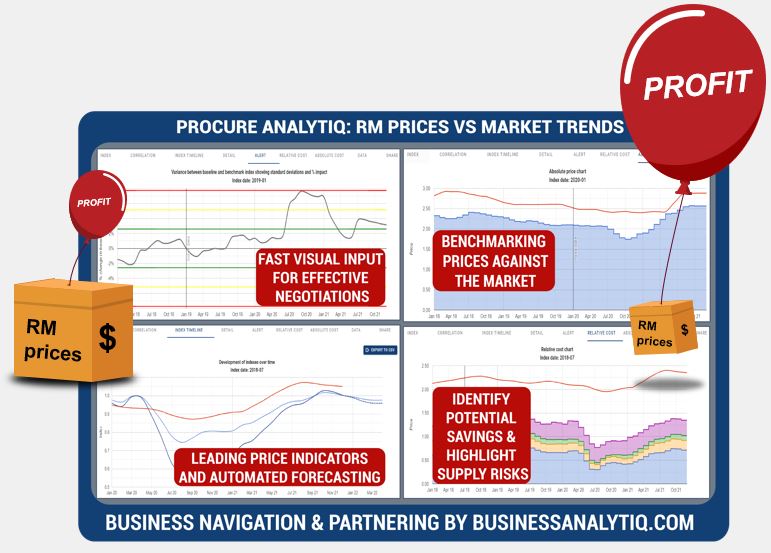Calcium Ammonium Nitrate price April 2024 and outlook (see chart below)
- Northeast Asia:US$0.22/KG, unchanged
- Europe:US$0.26/KG, unchanged
- North America:US$0.26/KG, unchanged
Business Analytiq assumes no responsibility or liability for any errors or omissions in the content of this site. The information contained in this site is provided on an “as is” basis with no guarantees of completeness, accuracy, usefulness, or timeliness.
Calcium ammonium nitrate (CAN) price index
This post is a summary of the Calcium ammonium nitrate (CAN) price developments. The price developments of Calcium ammonium nitrate (CAN) are expressed in US$ prices converted FX rates applicable at the time when the price was valid. Calcium ammonium nitrate (CAN) price index developments are calculated from multiple separate sources of data to ensure statistical accuracy.
The outlook for CAN prices, on the second tab, is generated from different inputs including:
- Very recent price developments of immediate cost drivers of Calcium ammonium nitrate (CAN) prices
- Recent price developments of underlying feedstocks which drive the price of Calcium ammonium nitrate (CAN)
- Market futures for both cost drives and feedstocks of Calcium ammonium nitrate (CAN) prices
- Adjustment of current supply/demand imbalances in the Calcium ammonium nitrate (CAN) market
- Longer term trends in likely demand conditions
Further information on the Calcium ammonium nitrate (CAN) price index
What is Calcium ammonium nitrate (CAN)
Calcium ammonium nitrate (CAN) is a fertilizer that is made by combining ammonium nitrate and calcium carbonate. The resulting compound is a white or grayish granular solid that contains nitrogen and calcium, two essential nutrients for plant growth.
CAN is commonly used as a fertilizer in agriculture, as it releases nitrogen and calcium slowly over time, providing a steady supply of nutrients to plants. It is particularly well-suited for use in acidic soils, as the calcium in CAN can help to raise the soil’s pH level and improve its fertility.
In addition to its use as a fertilizer, CAN is also used in other applications, such as in the production of cold packs, as a gas storage material, and as a source of nitrogen in the manufacturing of explosives.
Like ammonium nitrate, CAN is a highly reactive material that can be dangerous if not handled properly. It can be explosive under certain conditions, so it is important to store and handle it with care and follow appropriate safety guidelines.
How is Calcium ammonium nitrate (CAN) produced
Calcium ammonium nitrate (CAN) is produced by combining ammonium nitrate and calcium carbonate. The process involves the following steps:
Production of ammonium nitrate
Ammonium nitrate is typically produced by reacting ammonia gas with nitric acid. The reaction produces ammonium nitrate and water. The resulting solution is then concentrated and dried to form solid ammonium nitrate.
Production of calcium carbonate
Calcium carbonate is a naturally occurring mineral that can be found in rocks and shells. It can also be produced by reacting calcium oxide with carbon dioxide. The reaction produces calcium carbonate and heat.
Combination of ammonium nitrate and calcium carbonate
The solid ammonium nitrate is then mixed with solid calcium carbonate in the proper proportion. The two materials react to form solid calcium ammonium nitrate and carbon dioxide gas. The reaction is typically carried out in a granulator, which produces a granular product.
Drying and screening
The resulting product is then dried and screened to remove any oversized or undersized particles, and to produce a product with the desired size distribution.
The resulting calcium ammonium nitrate product is a white or grayish granular solid that contains both nitrogen and calcium. It is used primarily as a fertilizer in agriculture, as it provides a slow-release source of nitrogen and calcium to plants.
What is Calcium ammonium nitrate (CAN) used for
Calcium ammonium nitrate (CAN) is primarily used as a fertilizer in the agriculture industry, as it provides a slow-release source of nitrogen and calcium to plants. The nitrogen in CAN is released gradually over time, which helps to ensure that the plant receives a steady supply of nutrients over an extended period. The calcium in CAN also helps to improve the soil’s fertility, particularly in acidic soils.
In addition to its use as a fertilizer, CAN is also used in other applications, including:
Explosives
CAN can be used as a source of nitrogen in the production of explosives.
Snow and ice melting
CAN can be used to melt snow and ice on roads and sidewalks, as it releases heat when it dissolves in water.
However, the primary use of CAN is as a fertilizer, and the vast majority of the CAN produced is used for this purpose.
Which countries produce the most Calcium ammonium nitrate (CAN)
The production of calcium ammonium nitrate (CAN) is concentrated in a few countries. According to the latest available data, the countries that produce the most CAN are:
Russia
Russia is the largest producer of CAN in the world, with an estimated production of over 4 million metric tons in 2020. Russia is home to several large fertilizer producers, including EuroChem Group, which is one of the world’s largest producers of CAN.
China
China is the second-largest producer of CAN, with an estimated production of over 2 million metric tons in 2020. China has a large agricultural industry and is a major consumer of fertilizers, including CAN.
Ukraine
Ukraine is the third-largest producer of CAN, with an estimated production of over 1.5 million metric tons in 2020. Ukraine is a major agricultural producer and exporter, and the use of fertilizers such as CAN is widespread in the country.
Germany
Germany is the fourth-largest producer of CAN, with an estimated production of over 1 million metric tons in 2020. Germany is home to several large chemical companies that produce fertilizers, including CAN.
Belgium
Belgium is the fifth-largest producer of CAN, with an estimated production of over 500,000 metric tons in 2020. Belgium is home to several large chemical companies that produce fertilizers, including CAN.
Other major producers of CAN include the United States, Canada, and the Netherlands.
How big is the Calcium ammonium nitrate (CAN) market
The global market for calcium ammonium nitrate (CAN) is significant, with an estimated value of over USD 2.5 billion in 2020. The market is driven primarily by the use of CAN as a fertilizer in the agriculture industry, as it provides a slow-release source of nitrogen and calcium to plants. The demand for CAN as a fertilizer is expected to continue to grow, as the global population increases and demand for food rises.
In addition to its use as a fertilizer, CAN is also used in other applications, such as in the production of cold packs and as a gas storage material. However, the use of CAN in these applications is relatively small compared to its use as a fertilizer.
The market for CAN is highly competitive, with many major players in the industry, including Yara International ASA, EuroChem Group, CF Industries Holdings Inc., and others. The market is also affected by factors such as regulations, trade policies, and global economic conditions.
According to https://oec.world/ :
Calcium-ammonium nitrate mix, double salts pack >10kg are the world’s 2641st most traded product.
In 2020, the top exporters of Calcium-ammonium nitrate mix, double salts pack >10kg were Norway ($180M), China ($116M), South Africa ($33.1M), Czechia ($21.1M), and Slovakia ($20.1M).
In 2020, the top importers of Calcium-ammonium nitrate mix, double salts pack >10kg were United States ($61M), Mexico ($38.8M), India ($29.9M), Kenya ($28.5M), and Spain ($26.1M).
Further reading
Business Analytiq
BE THE FIRST TO SEE RISK AND OPPORTUNITY!
BusinessAnalytiq provides unlimited market trend data and an online tools to track market developments, key benchmarks & leading indicators.
BusinessAnalytiq leads to price visibility, better negotiations, easier budgeting and forecasting, lower raw material prices, and improved better internal and external communication. BusinessAnalytiq will decrease risk and higher profit.

Where does the data come from?
- The source of the data are exclusively public non-confidential sources. We have no access to primary data
- This the index trend of the price trend of the "product category" in general, and not a single specification of the product in particular
- The data is a combination of contract and spot pricing
- Our algorithms are set up to eliminate significant product mix impact on the reported price
- We combine public publications, import/export records, trading prices, company announcements, magazine articles, tweets, and other sources of ad-hoc public information.
- The chart shows the our best approximation of the market trend based on our algorithm interpretation of the signals
- For most indexes we have multiple sources and we focus on using statistically-correlated sources
- As a function of our automation, it is likely that recent trends will be adjusted as we discover more information. So, for example, the price trend for February 2024 will be first calculated in February 2024 and adjusted in March, April and May 2024.
- We will update the data trend as more information becomes available, and this means that recent trends will always be adjusted as we get more data available
- The algorithm will regularly revise our understanding of market trends, and indicated market trends may change
- The data is presented in US$. The UOM of measure is shown in the Index list table
- Our automated software and we do our best to create an accurate representation of the trend
Where does the data NOT come from?
- We do not purchase data from any other source and republish it.
- We will not purchase data from any other source and republish it
- We do not extrapolate trends, even for the forecast. We look for other market signals and leading indicators
What data should our company use?
- If you are making decisions driving significant share of profit, we always recommend that you buy data from the companies who invest in direct primary market access such as ICIS, amongst many others
- Our data, at best, represents an estimate of the market trend based on public information
- We have no direct access to the market, and we do not interview suppliers and customers
- Our automated analysis tools in the online software are set up to combine our data with other sources of data
- We do not recommend that you use our data for direct price mechanisms, as we may change and improve the data trends over time, including historical data
What does the quality indication in the main menu mean?
- Quality level A: Data is from a reliable and confirmed source
- Quality level B: Data is from multiple credible sources and there are no major statistical inconsistencies between them
- Quality level C: Data is from multiple credible sources and there are some statistical inconsistencies between them
- Quality level D: Data is from a single credible source, but we cannot verify the data
- Quality level E: Data is either:
- From a single source, which we consider reliable, but we cannot verify the data.
- From 2 or more sources which have some periods of contradicting trends.
- Quality level F: Data is from a single source which we consider indicatively correct, but the data is anecdotal and we cannot verify the data.
What are the disclaimers?
- We assume no responsibility or liability for any errors or omissions in the content of this site.
- The information is provided on an “as is” basis with no guarantee of completeness, accuracy, usefulness, fitness for purpose or timeliness.
- By their nature, outlooks are always uncertain
How often do we update the data?
- We aim to update the data series on the 9th and 24th of each month (but we do not always make it for each chart)
- The data for the current month and recent history are fine-tuned over time.
What are we doing to improve the data?
- We are continually improving our data collection and processing methods
- Pricing data will be updated from time to time as we improve the accuracy
- We are reviewing all data sources in the first half of 2024.
- There will be continuous fine-tuning of the trend and forecast algorithm as part of that.
- The key focus in 2024 is to add many additional indexes
How can i give feedback on the data or request for new indexes
- Feel free to contact us if you have a specific request. You can reach us via the Contact us page

